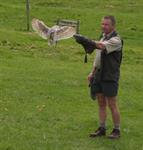
STUDY NATURE PARK MANAGEMENT
- Learn about managing the environment, animals and plants
- Learn about provision of visitor services
- Expand your potential for a career in park management
- Study on CD, with printed notes, or online (your choice)
This course is a natural progression from Nature Park Management I, but can be taken in its own right. It concentrates more on native plants and using them to create natural, balanced ecosystems. Over 15 lessons you also learn to create nature trails, build rockeries and pathways, construct ponds and watercourses, design picnic grounds and animal enclosures, market a nature park, and lots more.
Lesson Structure
There are 10 lessons in this course:
-
Natural Environments – preserving natural environments; plant associations and environment rehabilitation
-
Recreation and the Environment – impact of recreation on natural environments
-
Wildlife Management in Nature Parks – impact of park visitors on wildlife; managing wildlife
-
Visitor Amenities in Nature Parks – design; provision of visitor amenities including picnic areas and campgrounds; management of facilities
-
Park Interpretation – interpretative facilities including signs and education programs
-
Trail Design and Construction – designing access routes in parks; designing and constructing walking tracks
-
Water Areas – conserving and managing natural water bodies in nature park; impact of humans on water areas
-
Marketing Nature Parks – strategies used to promote nature parks
-
Risk Management I – identifying, minimising and managing natural hazards; safety issues
-
Risk Management II – preparing a risk management plan
Aims
-
Explain the role of nature parks in preserving natural environments.
-
Explain the role of nature parks as a recreation resource.
-
Explain the issues of managing wildlife in nature parks.
-
Explain the design of visitor amenities in nature parks and their impact on the environment.
-
Explain the role interpretative facilities in nature parks.
-
Explain the design and construction of trails within nature parks.
-
Explain the importance and management of natural water areas in nature parks.
-
Explain the importance of effective marketing in promoting nature parks.
-
Explain safety issues and hazard management in nature parks.
-
Explain the use of risk management plans in nature parks.
What You Will Do
-
Creation & Maintenance of Australian Ecosystems - Plant associations, earthworks.
-
Rockeries -Types of rock groupings, plants and rockeries.
-
Propagation - Techniques, seed, cuttings, etc.
-
Marketing - Advertising, brochures, etc.
-
Eucalyptus - Introduction to/use of Eucalypts.
-
Proteaceae Natives -Introduction to and use of the main Proteaceae genera.
-
Australian Legumes -Introduction to Mimosaceae(e.g. Acacia), Caesalpinaceae (e.g. Cassia)and Fabaceae (e.g. Kennedya).
-
More Native Plants - Introduction to other Australian plant genera; e.g. ferns, conifers, Melaleuca, Callistemon.
-
Wildlife Park Management - Keeping animals: legislation, enclosures, permits, etc.
-
Picnic Areas - facilities, litter, etc.
-
Playground Design - Equipment, materials, safety, costing, etc.
-
Paths & Paving - Types of pavers, laying paths and pavers.
-
Water Landscapes - Water features, pools, maintenance, etc.
-
Park Interpretation - Techniques, program design, etc.
-
Trail Design & Construction - Fun & fitness trails, surfacing materials, design.
 MANAGING WILDLIFE IN NATURE PARKS
MANAGING WILDLIFE IN NATURE PARKS
Wildlife management is just one of the major roles of nature parks. Indeed, the survival of many species of animals, from insects to large mammals, depends on the existence of nature parks which are dedicated to preserving the ecosystems that support animal life.
What is wildlife management?
Just as humans do, wild animals have needs such as food, shelter, reproduction, movement. The area that a wild animal normally lives in is known as its habitat. Wildlife management is the manipulation of wild animal populations and their habitats for the benefit of both humans and the wild animals. Wildlife management includes running parks and reserves, altering and rehabilitating wildlife habitats, pest control, protecting human life and property, and managing harvests of wildlife.
Controlling populations of wildlife usually takes one of the following forms:
1. Managing wildlife habitats
2. Managing people
3. Managing individuals in populations so that the population will either change or remain constant.
Approaches to Wildlife Management
Preservation
Preservation is where man simply leaves a natural system alone. Basically, areas are protected from destruction and are left so that nature takes its course. When nature takes its course, it may not always be favourable for the wildlife involved as change is inevitable in natural systems.
Conservation
Conservation is where man actively manages a natural system to maintain and use natural resources in such as way as to preserve it for future generations.
Management
Management is the focus of this course. It involves the manipulation of populations. This manipulation may be in order to increase the size of the population; to “harvest” animals in a sustainable way; or to reduce/stabilise a population. Management can be applied to both pest and desirable species.
Goals of Wildlife Management
The goals of wildlife management vary considerably with the situation. Goals of wildlife management include:
- to maintain a desirable population at a certain level.
- to reduce the population of an undesirable species.
- to allow for sustainable removal of animals from a population – for example, for hunting purposes.
- to increase numbers of an endangered species.
What Next?
Studying Wilderness Management II will boost your understanding of the art and science of park management and care, and expand your employment horizons. Enroll now, or please contact us if you have questions or need help with career planning.
More Courses to Consider
We have many other courses that complement Nature Park studies and may be of interest. Some of these are listed below.
Suggested Reading
Our academic staff have written a wide range of reference books, many specifically designed to fit the needs of our students. Click on any of the following titles to visit our online book store and see details on that book.
